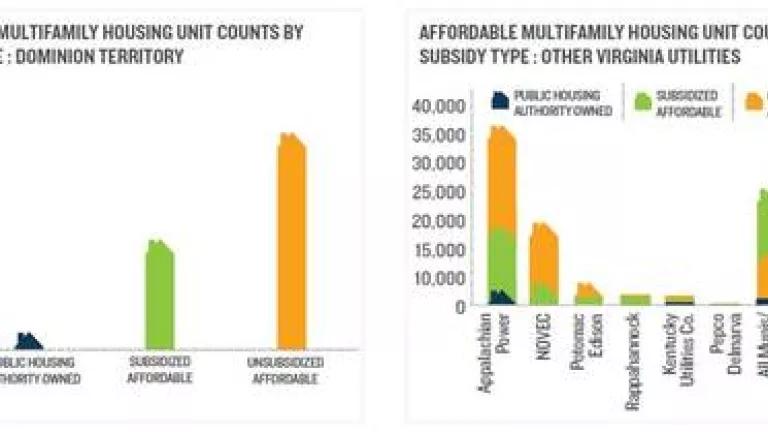
Energy efficiency program leaders at Virginia's largest utility, Dominion Power, just took a step forward by making a $57 million investment in low-income home improvements. While we await important details about the program, it's worth exploring its origin and potential for beginning to improve Virginia's energy future.
First of all, what Dominion does is by definition important to Commonwealth families of modest incomes, in part because its service area includes most affordable multifamily housing in the state as you can see from the graphs below (we look to Appalachian Power especially to unveil new programs next).
What spurred new program development activity and investment in low-income energy efficiency now? Legislation. Specifically, an overall deplorable rate-freeze bill enacted in February also included this modest provision:
Each...Utility shall conduct a pilot program for energy assistance and weatherization for low income, elderly, and disabled individuals in their respective service territories in the Commonwealth. Each pilot program shall be funded by the utility and shall commence September 1, 2015. Each such utility shall report on the status of its pilot program, including the number of individuals served thereby, to the Governor, the State Corporation Commission, and the Chairmen of the House and Senate Commerce and Labor Committees and Labor Committees by July 1, 2016, and each year thereafter.
Dominion has since reached out to groups including members of the newly formed Multifamily Energy Efficiency Coalition, which is led by the Virginia Housing Coalition and which includes a variety of housing, energy and environmental organizations including NRDC. That means they've had easy access to growing evidence of untapped potential to save energy, especially in affordable multifamily homes.
For example, Optimal Energy studied potential in 8 states including Virginia and found it's possible to cost-effectively save 28 percent of electricity and 19 percent of natural gas used in affordable multifamily housing by 2035 (with a return-on-investment of $2.90 for every dollar invested, pdf of Virginia-specific fact sheet here). Additionally, Housing Virginia and the Center for Housing Research at Virginia Tech recently performed a robust retrospective study of more than 300 units that were improved using respected Earthcraft standards as part of the Virginia Housing Development Authority's low income housing tax credit program. The researchers found an average 30 percent energy savings compared to standard new housing, with a family of four with an average median income of $77,500 saving a respectable $648 per year.
There is a huge amount of untapped potential in Virginia, with current programs making limited but encouraging inroads. This matters a lot for these particular households, since energy costs hit modest low-income budgets hardest and multifamily housing is the most energy-inefficient of stock on a per-square-foot basis. Easing the budgetary strain allows families to devote scarce dollars to healthy food, health care, educational activities and other more worthy investments. This is why, as Governor Terry McAuliffe aptly put it today: "...[I]t's fulfilling to extend this important service to multi-family residences and to brave veterans who, in many cases, return stateside to face unemployment and homelessness."
And thankfully there are an increasing number of best practices from other states and utilities, such as the 12 Energy Efficiency for All compiled and described in a Program Design Guide for use by utility administrators and others involved with program development.
This 5-year pilot project is a good start at saving loads of money currently wasted on energy in Virginia's affordable housing. The Multifamily Energy Efficiency Coalition stands ready to work with utilities, state agencies and other stakeholders towards successful implementation of this effort. One very helpful aspect of the pilot is that it's utility funded so there is flexibility to change and adjust quickly and nimbly in response to lessons learned. Let's hope that what we learn over the next 5 years in this pilot effort is the basis of a long term commitment by utilities to multifamily energy efficiency that can be a permanent part of the resource landscape in Virginia.
Let's get to work!
